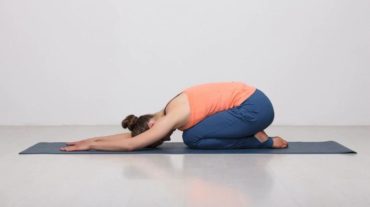[ad_1]
While acidity problems are common, even home remedies take a long time to show results due to the multiple increases in this condition. The biggest cause of gas and acidity is eating spicy, spicy and too sweet things. In addition to this, smoking, tea and coffee can also increase this problem, so if you are very troubled by this problem, make some simple yoga asanas part of your daily routine.
How Yoga Can Benefit Acidity
Yoga can prove to be very beneficial for improving acidity and gas problems. A medical study published on the NCBI (National Center for Biotechnology Information) website clearly states that meditation and yoga can reduce problems related to the digestive system, including acidity and gas.
Meanwhile, yoga practice helps prevent many digestive problems and their symptoms, according to another study. One of them is gastroesophageal reflux disease (GERD), which causes stomach acid and gas in the stomach. Research shows that regular practice of Kapalbhati and Agnisara Kriya can improve severe symptoms in people with GERD. On this basis, it can be hypothesized that yoga can be beneficial for gas and acidity.
Get rid of acidity and gas in a pinch with these yoga asanas
Ardha Matsyendrasana
When doing Ardha Matsyendrasana pose, the stomach is put under pressure, so there is more blood circulation in this area and the digestive system gets plenty of oxygen. Acidity problems are eliminated, while dirt is also removed from the body.
Do yoga like this –
- sit on the floor
- Now stretch your legs forward.
- Bend your left leg so that your heel touches the edge of your hip.
- Put your right foot on the ground near your left knee.
- Place your left arm on your right knee and hold the toes of your right foot with your left hand.
- Pull your right arm from your waist to your back and try to touch your belly button from behind.
- Turn your head to the right and try to look back.
- When you look back, watch you exhale.
- Do the poses according to your posture.
- It happens half cycle.
- Repeat the same movement on the other side.
- Now a cycle happens.
- Do three to five loops this way.
Vajra seat
Vajrasana is one such asana that doesn’t cause any problems even when done right after a meal, but it helps digest food and greatly reduces the chances of gas and acidity. in a yoga-related study. It is obvious that doing Vajra Yoga can help eliminate digestive problems. Studies have shown that it increases blood flow and is beneficial for constipation, acidity, hemorrhoids, intestinal gas, and more. In this way, Vajrasana counts acidity and gas in yoga.

Do yoga like this –
- First, lay out a mat and sit on your lap.
- Make sure the toes of both feet are connected together. Keep your ankles apart.
- Now place your hips on your ankles and your palms on your knees.
- Keep your head and back straight.
- Connect the knees together.
- Then close your eyes and continue breathing normally.
- Try to sit in this position for at least ten minutes.
- If your knee hurts while doing Vajrasana, don’t do it too hard.
- Try sitting in this position for a minute or two every day, and then gradually increase the time you spend doing it.
Adho Mukha Asana
Adho Mukha Svanasana pose is also effective in eliminating gas and acidity problems. When doing this pose, the weight of the entire body is on the hands and feet. The stomach gets the required amount of oxygen, which eliminates the burning sensation caused by the acidity.
Do yoga like this—
Stand on your hands and knees so that your body looks like a horse.
As you exhale, lift your hips, keeping your elbows and knees straight. You need to make sure the body forms an inverted “V” shape.
Keep your arms and legs as straight as possible, and keep your head straight, looking down.
Keep your palms straight on the ground and away from your shoulders, keeping your feet parallel to your palms.
Take a deep breath, hold this position for a few seconds, then bend your knees and return to the horse.
harasan
Halasana can be included in the yoga list for acidity and gas. When doing this asana, the body looks like a plow, hence the name Halasana. In a study published by NCBI, Halasana was found to be beneficial for constipation, indigestion, and other digestive problems. On this basis, it is believed that regular practice of harassana can relieve acidity and gas problems.

Do yoga like this—
- First, lay out a yoga mat on a flat surface.
- Now lie on the mat on your back.
- Keep your hands close to your body, palms facing the ground.
- Then, while breathing in, lift your feet up to a 90-degree angle.
- If you have difficulty lifting your legs, support your lower back with your hands.
- Then slowly exhale while trying to touch the ground with your toes.
- Now remove your hands from your waist and keep on the ground as before.
- Hold this position for normal breathing.
- Afterwards, return to the normal position comfortably.
- You can do this yoga asana three to five times depending on your ability.
Barasan
Balasan’s approach also eliminates acidity issues. The internal organs of the abdomen are massaged well in the balasang pose so that all organs work properly.

Do yoga like this—
- Sit in the vajra posture, keeping your spine straight.
- As you inhale, move your hands up.
- As you exhale, bend forward to your upper waist while keeping your arms straight and your forehead on the ground.
- Hold this position for 30 seconds to a few minutes.
- Then go back to Vajra pose.
Villabadrasana 2
Virabhadrasana 2 This asana is also known as Warrior Pose 2 and it is very effective in removing acidity. This asana overcomes most stomach related problems. By doing this asana, the digestive system remains strong and healthy.
Do yoga like this—
- Stand with your feet 3 to 4 feet apart, as convenient.
- Rotate the right leg 90 degrees to the right and the left foot 15 degrees to the right. Make sure your right leg should be in line with your left leg.
- Raise your hands parallel to your shoulders, on your left and right shoulder lines, palms down.
- The hands should be parallel to the ground. Exhale, bend your right knee so that your right thigh is parallel to the ground behind your knee.
- Remember that the right knee and right ankle should be in line, and the leg should be at a 90-degree angle to the thigh.
- With your knees not over your ankles, turn your head to the right and look at your right palm. Keep the left leg fully extended. Don’t let your knees bend. Keep your hands stretched.
- Stabilize the pose and slowly lower your pelvis, becoming stable in this pose like a warrior. Keep inhaling and exhaling evenly as you keep smiling. If you have any questions, please contact a yoga expert.
- This is the perfect position for the asana. Stay here for 20 to 30 seconds. The time can be increased later after practice. As you inhale, stand up and step back, doing the opposite.
- As you exhale, lower your hands slowly. Relax your hands behind your back. Now repeat this movement from the left side as well and get into the pose. This can be repeated 2 to 5 times depending on capacity.
[ad_2]



Leave a comment